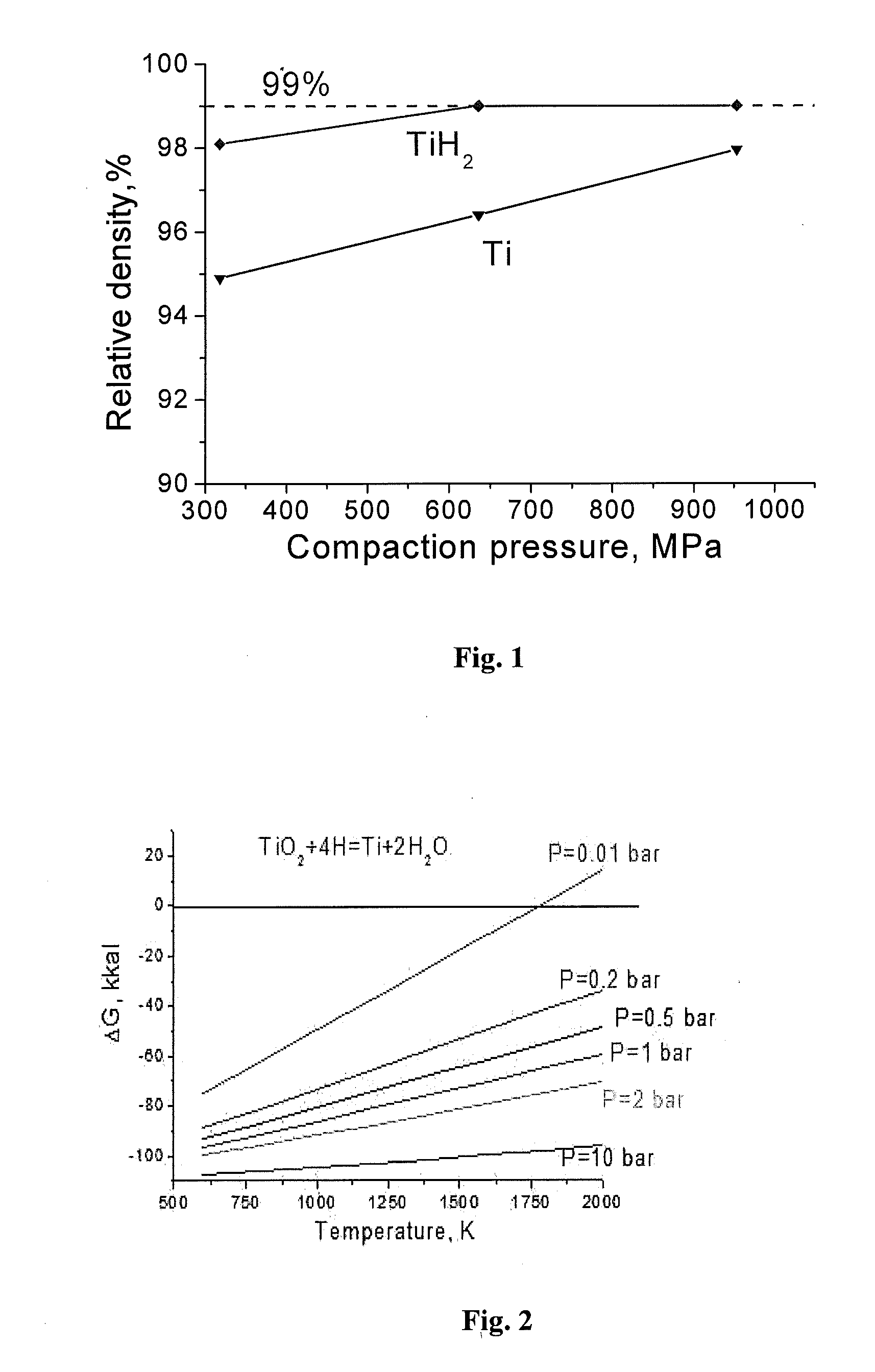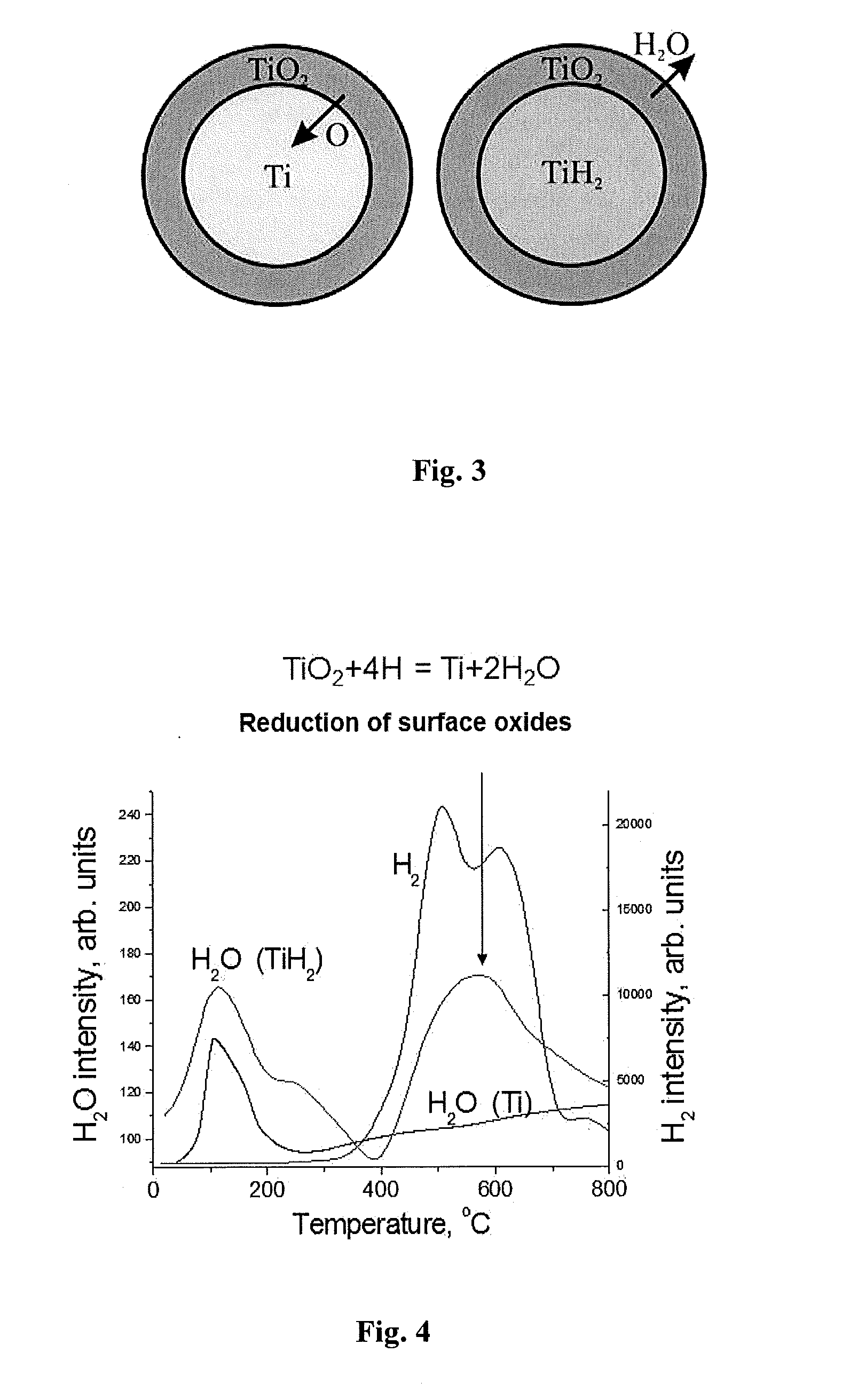Manufacture of near-net shape titanium alloy articles from metal powders by sintering with presence of atomic hydrogen
- Summary
- Abstract
- Description
- Claims
- Application Information
AI Technical Summary
Benefits of technology
Problems solved by technology
Method used
Image
Examples
example 1
[0080]A powder blend of three hydrogenated titanium powders containing different amount of hydrogen was used: (1) 25% of hydrogenated titanium powder containing 0.5 wt. % of hydrogen, particle size 2 powder containing 3.8 wt. % of hydrogen, particle size 3.
[0081]The green compact, having the thickness 12 mm, was heated to 250° C. at a slow heating rate of ˜7° C. / min and held at this temperature for 40 min to release absorbed water from the titanium powder. Then, heating was continued at the heating rate of ˜22° C. / min to a temperature in the range of 480-500° C. in the atmosphere of emitted hydrogen, and held at this temperature for 30 min to form β-phase titanium and to release reaction water from the hydrogenated titanium powders.
[0082]Almost complete reduction of surface oxides of the green compact particles by emitted atomic hydrogen was carried out by further heating the green compact to a temperature of 630° C. and holding at this temperature for 45 min, when the green compact...
example 2
[0093]A powder blend of two types of powders was used: (1) 20% of CP titanium powder, which does not contain hydrogen at all, particle size 2 powder containing 3.5 wt. % of hydrogen, particle size <100 microns.
[0094]These powders were mixed together, and the obtained mixed powder was compacted at 780 MPa to a low density green compact of 3.24 g / cm3.
[0095]The green compact having the thickness 24 mm was heated to 230° C. at a slow heating rate of ˜7° C. / min and held at this temperature for 80 min to release absorbed water from the powder. Then, heating was continued at the heating rate of ˜22° C. / min to 560-580° C. in the atmosphere of emitted hydrogen and held at this temperature for 25 min to form β-phase titanium and release reaction water from the powder.
[0096]Almost complete reduction of surface oxides of green compact particles by emitted atomic hydrogen was carried out by further heating the green compact to 700° C. and holding at this temperature for 35 min when the green com...
example 3
[0107]A powder blend of three types of powders was used: (1) 70 wt. % of titanium hydride powder TiH2 containing 3.8 wt. % of hydrogen and having particle size less than 120 μm, (2) 20% wt. % of CP titanium powder, which does not contain hydrogen, particle size <150 microns, and (3) 10 wt. % of the 60Al-40V master alloy powder having particle size <65 μm.
[0108]These powders were mixed together, and the obtained mixed powder was compacted at 960 MPa to a low density green compact of 3.46 g / cm3.
[0109]The green compact having the thickness 16 mm was heated to 250° C. at a slow heating rate of ˜7° C. / min and held at this temperature for 50 min to release absorbed water from the powders. Then, heating was continued at a heating rate of ˜20° C. / min to 580-600° C. in the atmosphere of emitted atomic hydrogen and held at this temperature for 30 min to form β-phase titanium and release reaction water from the powder.
[0110]Almost complete reduction of surface oxides of green compact particles...
PUM
| Property | Measurement | Unit |
|---|---|---|
| Temperature | aaaaa | aaaaa |
| Temperature | aaaaa | aaaaa |
| Temperature | aaaaa | aaaaa |
Abstract
Description
Claims
Application Information
 Login to View More
Login to View More - R&D
- Intellectual Property
- Life Sciences
- Materials
- Tech Scout
- Unparalleled Data Quality
- Higher Quality Content
- 60% Fewer Hallucinations
Browse by: Latest US Patents, China's latest patents, Technical Efficacy Thesaurus, Application Domain, Technology Topic, Popular Technical Reports.
© 2025 PatSnap. All rights reserved.Legal|Privacy policy|Modern Slavery Act Transparency Statement|Sitemap|About US| Contact US: help@patsnap.com


